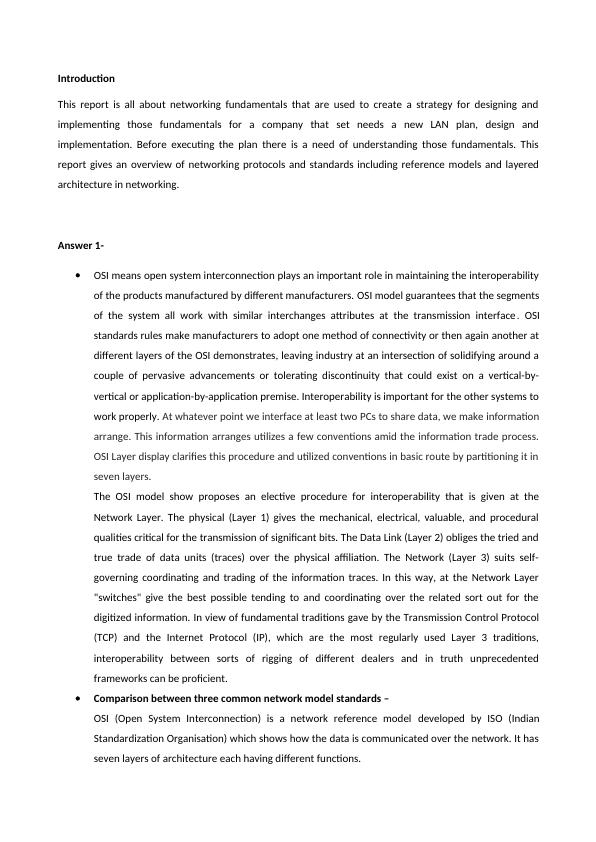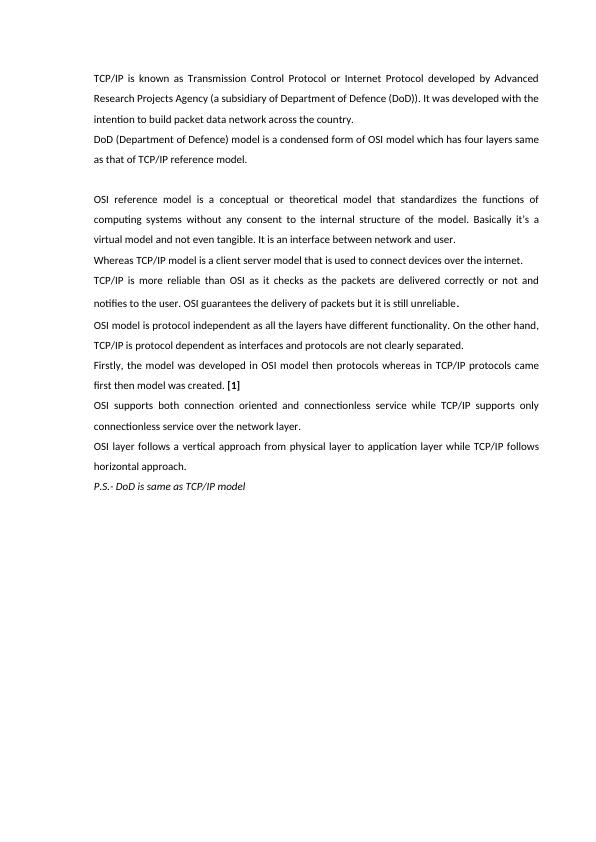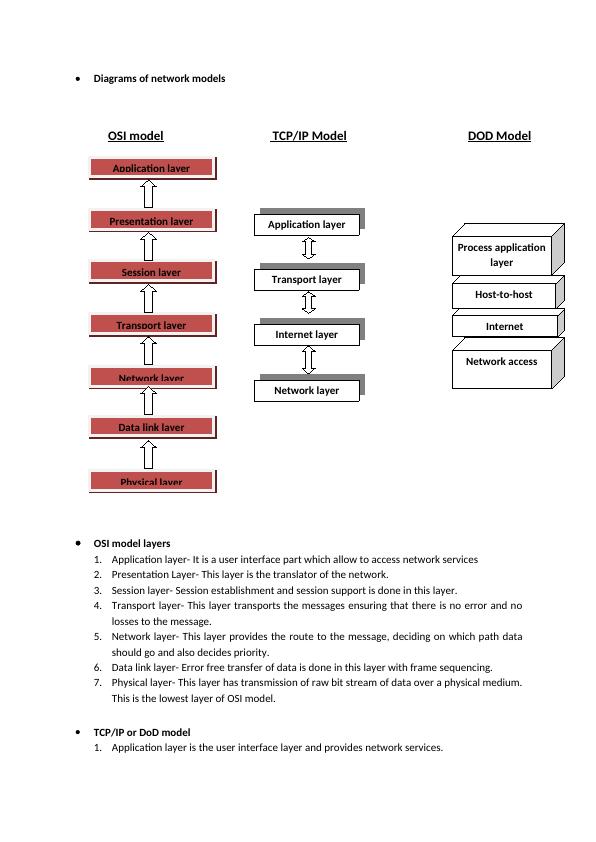Networking Fundamentals: Overview of Protocols, Standards and Cable Types
Added on 2023-06-12
8 Pages2229 Words137 Views
Introduction
This report is all about networking fundamentals that are used to create a strategy for designing and
implementing those fundamentals for a company that set needs a new LAN plan, design and
implementation. Before executing the plan there is a need of understanding those fundamentals. This
report gives an overview of networking protocols and standards including reference models and layered
architecture in networking.
Answer 1-
OSI means open system interconnection plays an important role in maintaining the interoperability
of the products manufactured by different manufacturers. OSI model guarantees that the segments
of the system all work with similar interchanges attributes at the transmission interface . OSI
standards rules make manufacturers to adopt one method of connectivity or then again another at
different layers of the OSI demonstrates, leaving industry at an intersection of solidifying around a
couple of pervasive advancements or tolerating discontinuity that could exist on a vertical-by-
vertical or application-by-application premise. Interoperability is important for the other systems to
work properly. At whatever point we interface at least two PCs to share data, we make information
arrange. This information arranges utilizes a few conventions amid the information trade process.
OSI Layer display clarifies this procedure and utilized conventions in basic route by partitioning it in
seven layers.
The OSI model show proposes an elective procedure for interoperability that is given at the
Network Layer. The physical (Layer 1) gives the mechanical, electrical, valuable, and procedural
qualities critical for the transmission of significant bits. The Data Link (Layer 2) obliges the tried and
true trade of data units (traces) over the physical affiliation. The Network (Layer 3) suits self-
governing coordinating and trading of the information traces. In this way, at the Network Layer
"switches" give the best possible tending to and coordinating over the related sort out for the
digitized information. In view of fundamental traditions gave by the Transmission Control Protocol
(TCP) and the Internet Protocol (IP), which are the most regularly used Layer 3 traditions,
interoperability between sorts of rigging of different dealers and in truth unprecedented
frameworks can be proficient.
Comparison between three common network model standards –
OSI (Open System Interconnection) is a network reference model developed by ISO (Indian
Standardization Organisation) which shows how the data is communicated over the network. It has
seven layers of architecture each having different functions.
This report is all about networking fundamentals that are used to create a strategy for designing and
implementing those fundamentals for a company that set needs a new LAN plan, design and
implementation. Before executing the plan there is a need of understanding those fundamentals. This
report gives an overview of networking protocols and standards including reference models and layered
architecture in networking.
Answer 1-
OSI means open system interconnection plays an important role in maintaining the interoperability
of the products manufactured by different manufacturers. OSI model guarantees that the segments
of the system all work with similar interchanges attributes at the transmission interface . OSI
standards rules make manufacturers to adopt one method of connectivity or then again another at
different layers of the OSI demonstrates, leaving industry at an intersection of solidifying around a
couple of pervasive advancements or tolerating discontinuity that could exist on a vertical-by-
vertical or application-by-application premise. Interoperability is important for the other systems to
work properly. At whatever point we interface at least two PCs to share data, we make information
arrange. This information arranges utilizes a few conventions amid the information trade process.
OSI Layer display clarifies this procedure and utilized conventions in basic route by partitioning it in
seven layers.
The OSI model show proposes an elective procedure for interoperability that is given at the
Network Layer. The physical (Layer 1) gives the mechanical, electrical, valuable, and procedural
qualities critical for the transmission of significant bits. The Data Link (Layer 2) obliges the tried and
true trade of data units (traces) over the physical affiliation. The Network (Layer 3) suits self-
governing coordinating and trading of the information traces. In this way, at the Network Layer
"switches" give the best possible tending to and coordinating over the related sort out for the
digitized information. In view of fundamental traditions gave by the Transmission Control Protocol
(TCP) and the Internet Protocol (IP), which are the most regularly used Layer 3 traditions,
interoperability between sorts of rigging of different dealers and in truth unprecedented
frameworks can be proficient.
Comparison between three common network model standards –
OSI (Open System Interconnection) is a network reference model developed by ISO (Indian
Standardization Organisation) which shows how the data is communicated over the network. It has
seven layers of architecture each having different functions.

TCP/IP is known as Transmission Control Protocol or Internet Protocol developed by Advanced
Research Projects Agency (a subsidiary of Department of Defence (DoD)). It was developed with the
intention to build packet data network across the country.
DoD (Department of Defence) model is a condensed form of OSI model which has four layers same
as that of TCP/IP reference model.
OSI reference model is a conceptual or theoretical model that standardizes the functions of
computing systems without any consent to the internal structure of the model. Basically it’s a
virtual model and not even tangible. It is an interface between network and user.
Whereas TCP/IP model is a client server model that is used to connect devices over the internet.
TCP/IP is more reliable than OSI as it checks as the packets are delivered correctly or not and
notifies to the user. OSI guarantees the delivery of packets but it is still unreliable.
OSI model is protocol independent as all the layers have different functionality. On the other hand,
TCP/IP is protocol dependent as interfaces and protocols are not clearly separated.
Firstly, the model was developed in OSI model then protocols whereas in TCP/IP protocols came
first then model was created. [1]
OSI supports both connection oriented and connectionless service while TCP/IP supports only
connectionless service over the network layer.
OSI layer follows a vertical approach from physical layer to application layer while TCP/IP follows
horizontal approach.
P.S.- DoD is same as TCP/IP model
Research Projects Agency (a subsidiary of Department of Defence (DoD)). It was developed with the
intention to build packet data network across the country.
DoD (Department of Defence) model is a condensed form of OSI model which has four layers same
as that of TCP/IP reference model.
OSI reference model is a conceptual or theoretical model that standardizes the functions of
computing systems without any consent to the internal structure of the model. Basically it’s a
virtual model and not even tangible. It is an interface between network and user.
Whereas TCP/IP model is a client server model that is used to connect devices over the internet.
TCP/IP is more reliable than OSI as it checks as the packets are delivered correctly or not and
notifies to the user. OSI guarantees the delivery of packets but it is still unreliable.
OSI model is protocol independent as all the layers have different functionality. On the other hand,
TCP/IP is protocol dependent as interfaces and protocols are not clearly separated.
Firstly, the model was developed in OSI model then protocols whereas in TCP/IP protocols came
first then model was created. [1]
OSI supports both connection oriented and connectionless service while TCP/IP supports only
connectionless service over the network layer.
OSI layer follows a vertical approach from physical layer to application layer while TCP/IP follows
horizontal approach.
P.S.- DoD is same as TCP/IP model

Diagrams of network models
OSI model TCP/IP Model DOD Model
OSI model layers
1. Application layer- It is a user interface part which allow to access network services
2. Presentation Layer- This layer is the translator of the network.
3. Session layer- Session establishment and session support is done in this layer.
4. Transport layer- This layer transports the messages ensuring that there is no error and no
losses to the message.
5. Network layer- This layer provides the route to the message, deciding on which path data
should go and also decides priority.
6. Data link layer- Error free transfer of data is done in this layer with frame sequencing.
7. Physical layer- This layer has transmission of raw bit stream of data over a physical medium.
This is the lowest layer of OSI model.
TCP/IP or DoD model
1. Application layer is the user interface layer and provides network services.
Application layer
Presentation layer
Physical layer
Data link layer
Network layer
Transport layer
Session layer
Application layer
Transport layer
Internet layer
Network layer
Process application
layer
Host-to-host
Internet
Network access
OSI model TCP/IP Model DOD Model
OSI model layers
1. Application layer- It is a user interface part which allow to access network services
2. Presentation Layer- This layer is the translator of the network.
3. Session layer- Session establishment and session support is done in this layer.
4. Transport layer- This layer transports the messages ensuring that there is no error and no
losses to the message.
5. Network layer- This layer provides the route to the message, deciding on which path data
should go and also decides priority.
6. Data link layer- Error free transfer of data is done in this layer with frame sequencing.
7. Physical layer- This layer has transmission of raw bit stream of data over a physical medium.
This is the lowest layer of OSI model.
TCP/IP or DoD model
1. Application layer is the user interface layer and provides network services.
Application layer
Presentation layer
Physical layer
Data link layer
Network layer
Transport layer
Session layer
Application layer
Transport layer
Internet layer
Network layer
Process application
layer
Host-to-host
Internet
Network access

End of preview
Want to access all the pages? Upload your documents or become a member.
Related Documents
Assignment on Networking Fundamentalslg...
|9
|1945
|470
Networking Fundamentals Assignmentlg...
|10
|2250
|133
(Solved) Networking Fundamentals : PDFlg...
|10
|1942
|200
Comparison and Contrast of OSI Model with TCP/IP Modellg...
|5
|1249
|450
Networking Fundamentals : PDFlg...
|12
|2090
|227
Assignment on TCP/IP Modellg...
|9
|1659
|155
